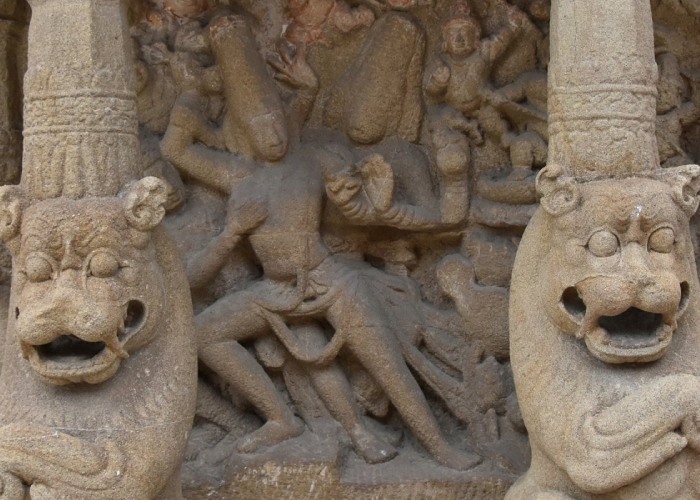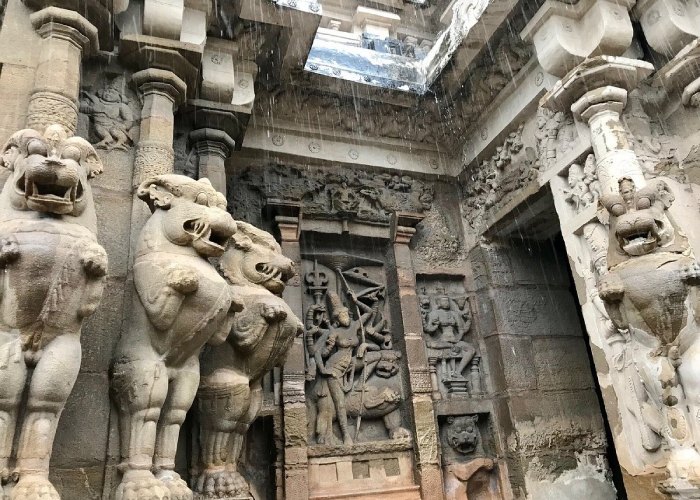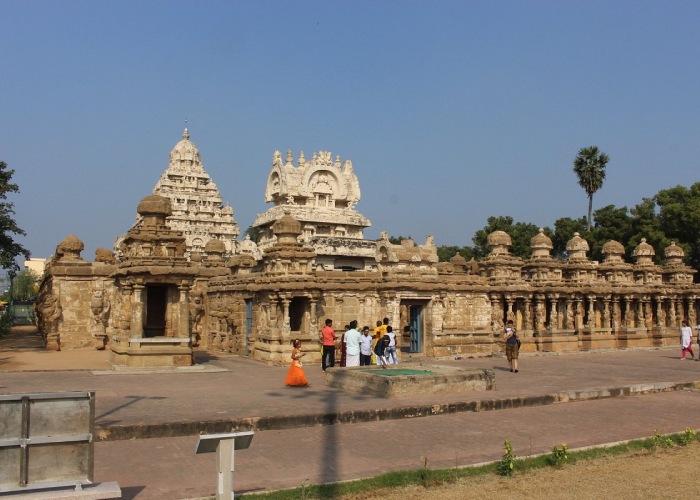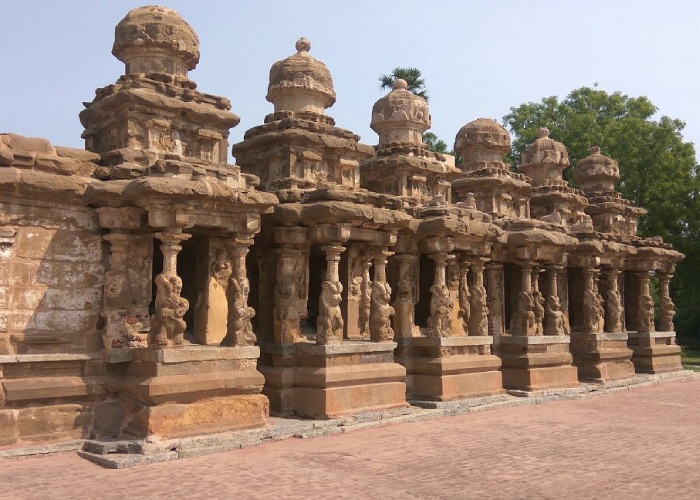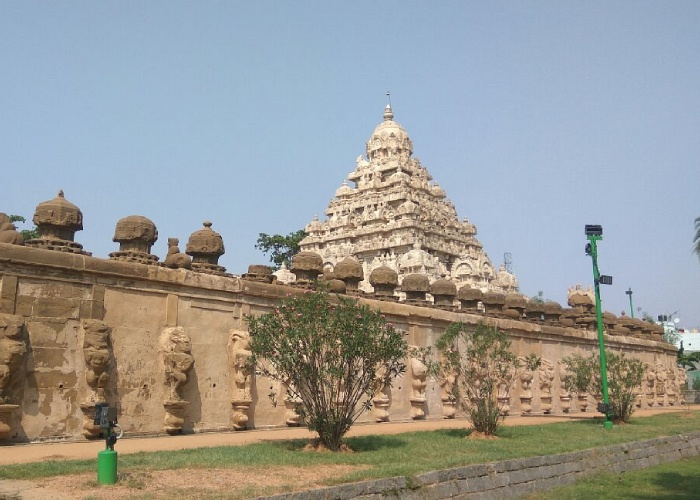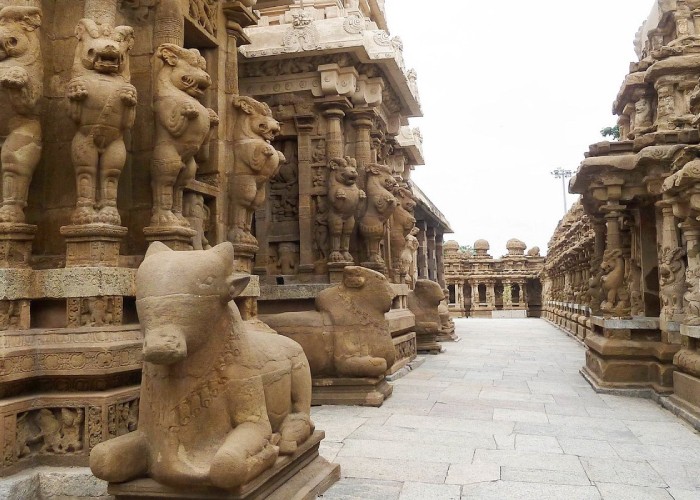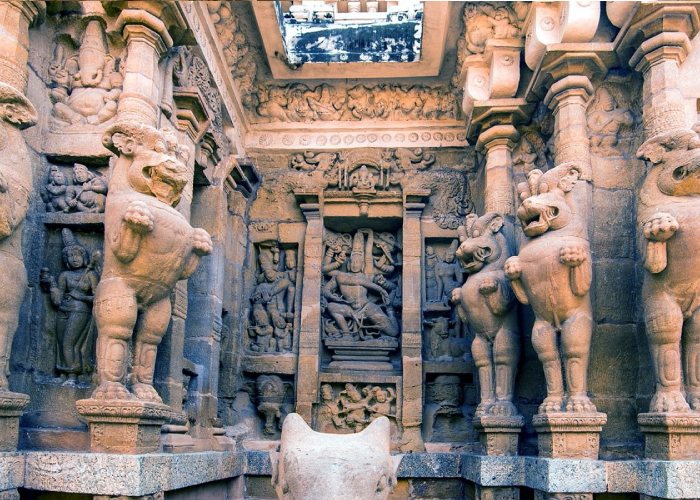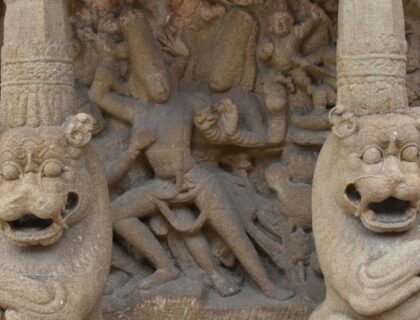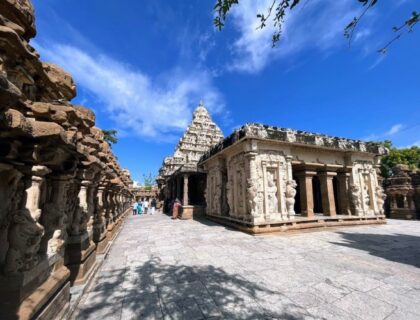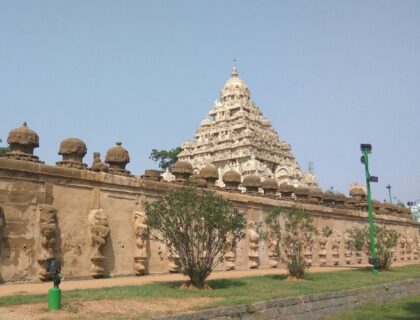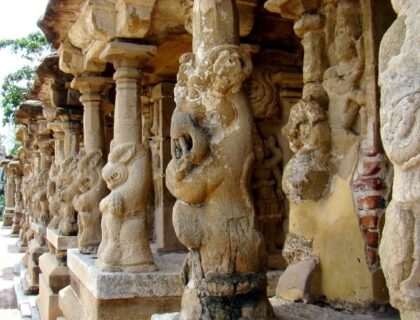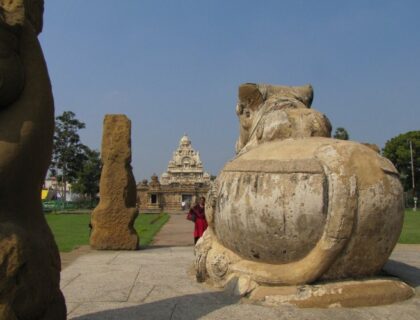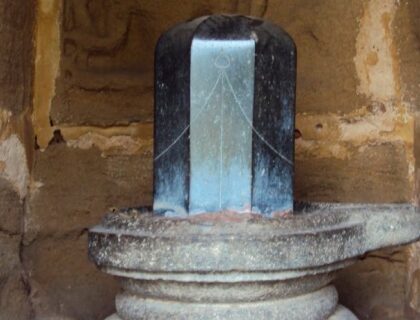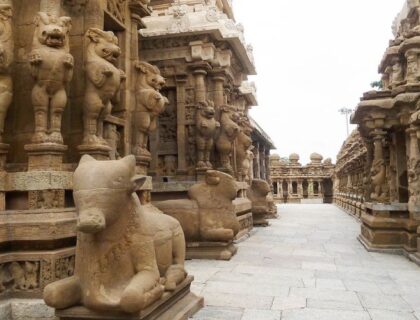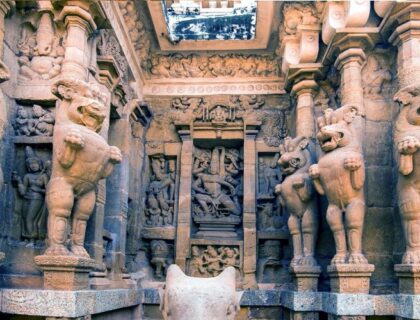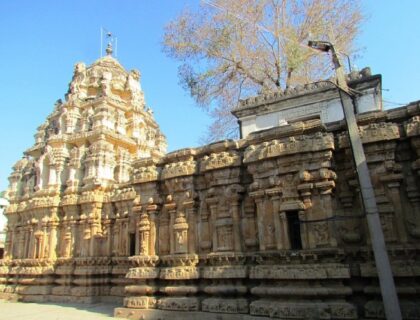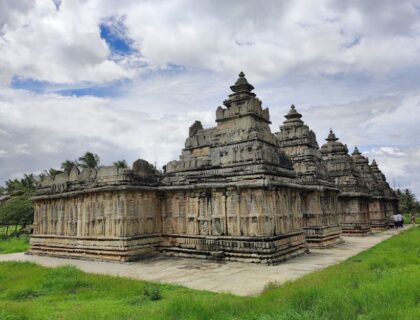Kailasanathar Temple Kanchipuram
The Kailasanathar Temple, Kanchipuram, also known as the Kailasanatha Temple, is a Pallava-era historic Hindu temple in Kanchipuram, Tamil Nadu, India. It is one of Kanchipuram’s oldest surviving monuments, dedicated to Shiva. It was built around 700 CE by Narasimhavarman II with additions by Mahendravarman III and reflects Dravidian architecture.
It is a square-plan temple with a mukha-mandapa (entrance hall), a maha-mandapa (gathering hall), and a primary garbha-griha (sanctum) that is topped by a four-story vimana. The main sanctum is surrounded by nine shrines, seven outside and two inside flanking the sanctum’s entrance, all depicting Shiva in various forms. Cells surround the outer walls of the temple’s prakara (courtyard).
Significance of Kailasanathar Temple
Kailashnathar temple is undoubtedly one of the finest jewels of Pallavan-era architecture. This masterpiece was commissioned by Pallavan king Rajasimha (Narasimhavarman II) and his wife Rangapataka, who took a special interest in building this temple, between 685 and 705 CE.

The temple was built in accordance with Smartta traditions (which include worship of Shiva, Vishnu, Sakti/Durga, Surya, Kartikeya, and Ganesha without regard for sectarianism). The temple’s plan is unique in its oblong shape, and it was the first to have a prakara or wall built around it.

The temple is also known for having one of the earliest and best examples of Hindu mural art in Tamil Nadu. This can be found in the courtyard cells’ inner walls. The murals are in the style of the Ajanta Caves, as well as the historic paintings in Kanchipuram’s 8th-century Vaikunthaperumal temple. Many inscriptions in early scripts can be found on the temple walls, which are important for epigraphic studies of regional history and Tamil temple traditions.
History of Kailasanathar Temple
The Kailasanathar Temple (meaning “Lord of Kailasa”) was built in the Smartha tradition of Hinduism and is dedicated to Shiva, Vishnu, Devi, Surya (Sun), Ganesha, and Kartikeya.

The Pallava dynasty is credited with temple construction after establishing their kingdom in Kanchipuram (also known as “Kanchi” or “Shiva Vishnu Kanchi”), which is considered one of Hinduism’s seven sacred cities. After Emperor Narasimhavarman I expanded the Pallavas’ territories to the north, west, and south within the Tamil, Andhra, and Kannada territories, they began expanding their capital city of Kanchipuram and building many magnificent temples.

The temple was built around 700 CE, with additions in the 8th century and later restorations. Narasimhavarman II (Rajasimha), also known as Rajasimha Pallaveswaram, built the first structural temple in South India. Mahendravarman III, his son, finished the front façade and the gopuram (tower). Previously, temples were made of wood or hewn into rock faces in caves or on boulders, as seen in Mahabalipuram. The Kailasanathar temple set the standard for similar temples in South India. According to local legend, the temple served as a safe haven for the kingdom’s rulers during wartime.
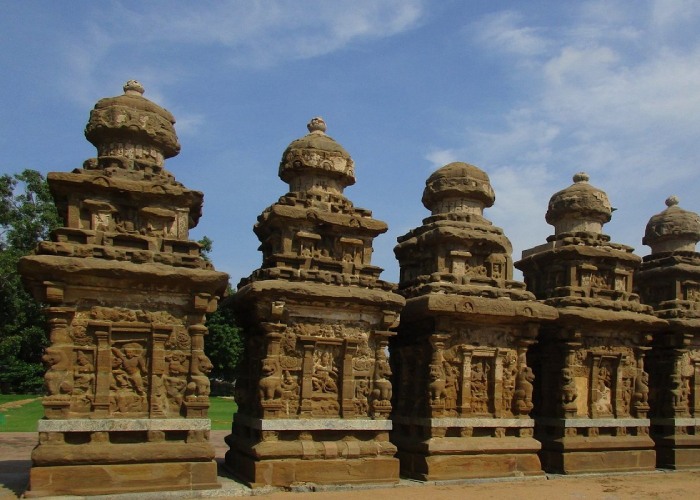
The kings built a secret tunnel as an escape route, which is still visible today. It is thought that Raja Raja Chola I (985-1014 CE) visited the temple and was inspired by it to build the Brihadeeswara Temple. Currently, the Archaeological Survey of India looks after Kanchi Kailasanathar Temple.
The Architecture of Kailasanathar Temple
The architecture is straightforward, with a plane or tower at the centre. The temple’s plan is square, and it rises in the shape of a pyramid above the main hall (sanctum sanctorum). Many levels in the tower rise in proportion.

At the top of the tower, a small dome-shaped roof can be seen. The decorative elements are Pallava-style pillar elements with mythical animal forms (lions on the base). At the entrance, the dome walls had been plastered.

The central tower is preceded by eight small shrines, one of which can be seen on the entrance wall. An intermediate hall then connects the mandapam and the sanctuary, Ardhamantapam, detracting from the temple’s beauty. The temple is surrounded by rectangular walls.
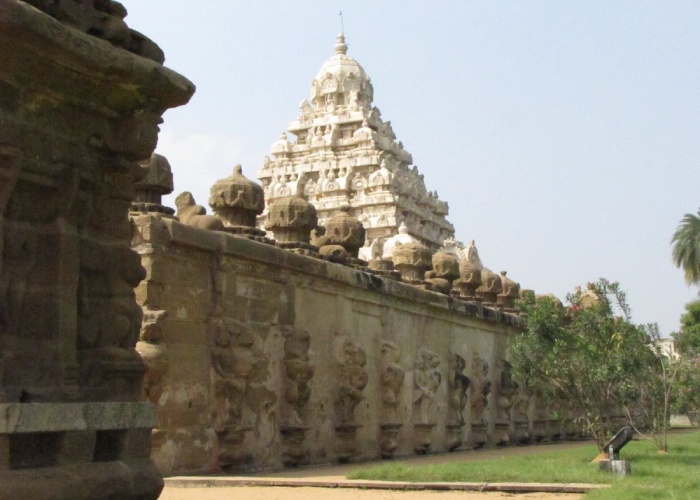
The main hall’s sanctum sanctorum contains a 16-sided Shiva lingam made of black granite stone. Within the main shrine’s walls is a pedestal (central pedestal) with beautifully carved images of deities and a sculpture guarding the deity from afar. On each face of the main temple’s outer walls are sculptures of various deities.
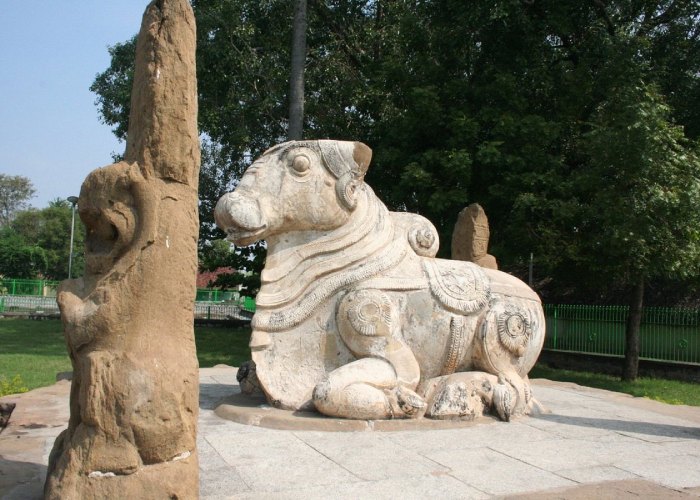
The sculpture on the south side wall depicts Lord Shiva as Umamaheswar (Lord Shiva with his wife Parvati) on the lower level of Lingodbhava, Brahma and Vishnu, and the flying immortals. The sculptures of Lord Shiva in the form of Sandhya Thandavamurti and Urdhava Thandavamurti, as well as paintings of Brahma, Vishnu, Nandi, and Parvati, are located in the west-facing hall.

The main shrine has a 16-sided Shivalinga made of black granite stone that is deified in the sanctum sanctorum. Within the walls of the main shrine, there is a padabhanda adhisthana (main pedestal) with very elegantly carved images of gods and a sculpted Nandi guarding the deity. Many deities are carved on each face of the main shrine’s outer walls.
Important Facts About Kailasanathar Temple
- The Kailasanathar Temple is dedicated to Lord Shiva and is located in Kanchipuram, near Chennai.
- Kailasam represents Lord Shiva’s heavenly abode, and Kailasanathar represents the Lord of Cosmic Mountain.
- It is one of the oldest and largest temples in Tamil Nadu. This temple is also dedicated to Planet Kethu, as many Shiva temples are, and this has a significant impact on the temple.
- Many Nayanmars and saints have been praised and worshipped at this temple. The temple complex contains nearly 60 shrines. The innermost pathway that ambulates Lord Kailasanathar and depicts a person’s entry and exit from paradise.
- The temple is known as Sandtemple because it was built with a lot of Sandstone.
- Lord Shiva in various forms, including Lord Dakshnamoorthy, Lord Lingothpavar, and Somaskandar, are carved here.
- One of the most notable architectural wonders is the presence of erect lions protruding from the walls.
- There are a number of statues of Lord Shiva playing the Veena. Several inscriptions about various Saiva Saints can be found in the temple.
- The temple was constructed between 685-705AD. Narasimhavarman II (Rajasimha), also known as Rajasimha Pallaveswaram, built the first structural temple in South India.
- The Kailasanathar temple set the standard for similar temples in South India. According to local legend, the temple served as a safe haven for the kingdom’s rulers during wartime.
- Several inscriptions on the temple walls attest to historical events, the Pallavas, and Rajasimha’s devotion to Siva.
- The garbhagriha houses a 16-sided Siva Lingam, which is quite unique (though regular-polygonal Siva Lingams are more common in Pallava temples than cylindrical Siva Lingams).
Best Time to Visit Kailasanathar Temple
This place is very heavenly and spiritual, and you can visit it all year. The best time to visit this temple, however, is during the monsoon and winter seasons. During the monsoon season, this location receives moderate to heavy rainfall, making it appear heavenly with its greenery and bringing freshness elsewhere.
Famous Festivals In Kailasanathar Temple
- Shravana: For happiness and wealth, many fasts, offerings, and mantras are performed during the fifth month of the Hindu calendar, known as Shravana.
- Mahashivaratri is a fasting ritual that takes place in the last week of February. It is reminiscent of Lord Shiva bringing Goddess Parvati with him. A Grand Celebration is arranged by priests and the temple committee.
How to Reach Kailasanathar Temple
By Air: The nearest airport to the temple is the Chennai International Airport. The temple is located at a distance of 80 km from the airport.
By Rail: The Kailasanathar temple is located near Kanchipuram Railway Station. To get an auto, you can take a bus or a taxi.
By Road: Kanchipuram is well connected to the majority of cities. There is an abundance of local transport. The bus stop is only a short distance away from the temple complex.
Also Read – Chennakeshava Temple Belur
Location
Facilities
- Drinking Water
- Pooja Item Shops
- Prasad Shops
- Restaurants Nearby
- Resting Room

